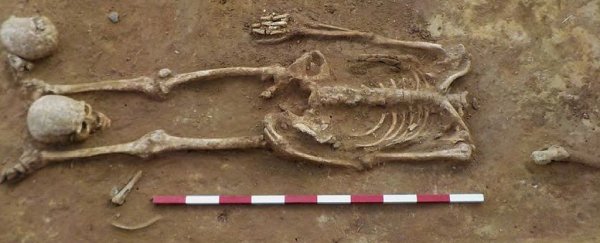An archaeological dig in Suffolk, England has yielded up a Roman-era cemetery treasure: 52 beautifully preserved skeletons dating back to the 4th century.
And of those skeletons, many had been decapitated, their disembodied heads placed neatly at their sides or feet for burial, or buried without bodies altogether. Only 17 skeletons had been buried normally.
It's a really rare and peculiar discovery, according to the archaeologists who found the remains.
"We weren't expecting to find this many or that well preserved," said archaeologist Andrew Peachey of Archaeological Solutions, the company conducting the survey ahead of a new housing development in the village of Great Whelnetham.
It's known that Great Whelnetham was a Roman settlement, starting around the mid- to late- first century CE, and occupied for nearly 2,000 years; but, because the ground is fine sand, it was expected that any skeletons would have long disintegrated.
So when the team started excavating skeletons, the remains of men, women and children of all ages, indicating that they had lived in the settlement, it was a surprise.
Generally speaking, the Romans buried their dead much like we do - laying on their backs, neatly arranged, often with significant items. But in every Roman cemetery, there can be found a number of what are called "deviant" burials that break from this norm.
What makes the Great Whelnetham cemetery so unusual is the number of deviant burials, Peachey told the BBC's Lesley Dolphin in an interview.
"What you rarely find - really only in three or four cemeteries throughout the country - is such a very high proportion of deviant burials," he said.
"To the point where, in this population, it should actually be regarded as the normal practice."
 (Archaeological Solutions)
(Archaeological Solutions)
There have been other Roman cemeteries found in the area, but only this one seems to have observed this practice - although why they did so is a mystery.
It's also worth noting that the deceased had not been executed. The archaeologists believe that the heads had been very carefully removed from the bodies after death, cut cleanly from the front just behind the jaw, unlike the violent, low cuts commonly found in executions.
Peachey notes that one explanation could be a segment of the population may have belonged to a known Roman cult that venerated the head as part of the soul, and removed the head as part of their religious burial rites.
Another possible explanation is that the population came from somewhere else far away, perhaps as slaves, bringing the burial practice with them.
"Part of our analysis going forward, and one of these emerging sciences which is continually getting better and better, is looking at proteins in the bones, is looking at isotope ratios in the bones, and we'd like to know where this population came from, and this might be able to tell us more about that," Peachey said.
What we do know about the deceased is that most of them had lived until middle age or later, although there was one small child and two children aged about 9 or 10 among the deviant burials.
They also had well developed upper bodies, meaning they probably worked in agriculture, and were well-fed, with access to sugars and carbohydrates, leading to poor dental hygiene.
A more detailed analysis will be conducted on the skeletons, which have been moved to a museum archive.
"The next part is to bring their story to life, and to make that history of the village, and of Suffolk in general," Peachey said.
